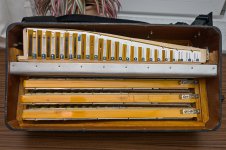Hi!
I'd like to understand the key differences between
I'd like to understand the key differences between
- Italian button accordion CBA e. g. Bugari 580/ARS/C, Pigini Master 58/B de Luxe
- Russian bayan e. g. Jupiter
- Italian button accordion with the word bayan in its name e. g. Bugari Bayan Selecta, Pigini Bayan 58/B de Luxe
- Right hand and left hand sound characteristics e. g. a Russian bayan is known for its strong bass
- The most common tuning configuration of reeds for each hand in terms of 16+8+4+2
- What usually the word bayan means for Italian button accordions with the word bayan it its name
- The most common number of chorus in each hand
- Any other important distinguishing characteristics of the above three categories
Last edited:


